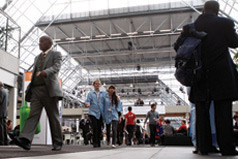Green lobbying in Copenhagen
on
Green lobbying in Copenhagen
Copenhagen is bustling with PR people trying to tell you that clean coal is the real deal, or that natural gas consumption needs to be boosted in favour of oil. Even the oil people proclaim that they need to be part of a sustainable solution. Everyone wants a piece of the climate cake, a huge pastry topped with giant amounts of cash. But lobbying is not reserved for big oil and gas. The renewable energy companies have also dispatched their industry leaders to the Bella Center in Copenhagen.
 |
| The Bella Conference Center in Copenhagen |
Power from onshore and offshore turbines accounts for up to 65 percent of the most recent climate change reduction pledges by the Annex I countries – these include the US, the EU, Norway, Japan and Russia – according to UNEP (United Nations Environmental Programme) Spokesman Nick Nuttall, who cited calculations by the Global Wind Energy Council. The industry group says wind energy in 2008 saved 157 million tons of CO2 – around 16 percent of the total Kyoto emissions reduction target for that same year.
The biggest potential for wind power lies within developing countries that can use the source to grow more sustainably, says Tulsi Tanti, the ceo of Suzlon, India’s largest wind power company. Founded by Tanti in 1995 with just 20 employees, Suzlon has transformed into a global player operating in 21 countries with some 15,000 employees and 10,000 MW worth of wind turbines installed. Rapid growth is not always sustainable. The company took hits because of the global economic crisis, has amassed considerable debt, and has had problems with its turbine production. For the fiscal year ending March 31, 2010, Suzlon is functioning at less than 50 percent of its 4,200 MW manufacturing capacity.
The global wind industry nevertheless expects a 22 percent growth until 2013, thanks mainly to booming demand in the United States, Europe, India and China. ‘But we’re not where we need to be in Latin America, in Africa and in the Pacific,’ said Steve Sawyer, the head of the GWEC.
Biggest hopes
That means in the developing countries – just where officials from the solar energy industry are putting their biggest hopes. The secretary-general of the European Photovoltaics Industry Association, Adel El Gammal, said Tuesday in Copenhagen that the Sunbelt countries (those near the equator, some 63 countries representing three quarters of the world population) are perfect candidates for PV power generation because they are characterized by a ‘fast-growing population, huge increase of electrical demand, and very poor infrastructure.’
In the Sunbelt, 1.6 billion people have no access to electricity and are highly dependent on fossil fuels. Off-grid and mini-grid solutions could provide green power at market cost in three to four years, El Gammal saÿs.
| The global wind industry expects a 22% growth until 2013 |
But it’s also a question of technological improvement. PV is still not competitive in Europe. While the industry says PV will produce at market prices in Italy by 2011, and a few years later in central Europe, critics say PV might be too late to profit from a Copenhagen deal. Don’t worry, replies El Gammal, claiming that there are estimates that the price of PV in Europe will go down by 60 percent over the next decade. ‘And even in 2020, there is a huge price reduction potential,’ he said.
By that same year, the solar energy industry could satisfy up to 12 percent of Europe’s electricity demand, and thus avoid 220 million tons of CO2 annually by 2020, the EPIA believes. The number of jobs linked to the industry – around 190,000 right now – will also rise substantially.
It’s clear to experts that tomorrow’s green energy mix will feature a broad mix of sources – from wind to solar, to biomass, geothermal energy and electric mobility. Sure enough, wind power officials didn’t mention solar energy when calling for a green future, and the solar industry people didn’t talk about wind turbines. The renewables companies used to team up to fight coal, oil and nuclear. They have now turned into competitors in the war over what source will replace the dirty fuels and become the next energy base.


Discussion (0 comments)